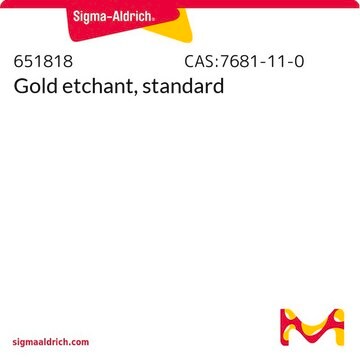643254
Gold coated glass cover slip
L × W × thickness 22 mm × 22 mm × 130-170 μm, square, 99.999% (Au), layer thickness 100 Å
Sign Into View Organizational & Contract Pricing
All Photos(1)
About This Item
Empirical Formula (Hill Notation):
Au
CAS Number:
Molecular Weight:
196.97
EC Number:
MDL number:
UNSPSC Code:
12352300
PubChem Substance ID:
NACRES:
NA.23
Recommended Products
assay
99.99% (Ti)
99.999% (Au)
L × W × thickness
22 mm × 22 mm × 130-170 μm, square
layer thickness
100 Å
refractive index
n20/587 1.523
matrix attachment
Titanium, as adhesion layer used to bind the gold to the borosilicate glass cover slip
SMILES string
[Au]
InChI
1S/Au
InChI key
PCHJSUWPFVWCPO-UHFFFAOYSA-N
Looking for similar products? Visit Product Comparison Guide
Related Categories
Features and Benefits
Corning® 0211 zinc titania glass, a particular formulation of borosilicate glass that lends itself very well to being sliced into thin pieces.
The gold surface is highly polycrystalline but shows a tendency towards <111> orientation.
Other Notes
Titanium adhesion layer used to bind the gold to a zinc titania glass cover slip.
Legal Information
Corning is a registered trademark of Corning, Inc.
Storage Class
13 - Non Combustible Solids
wgk_germany
nwg
flash_point_f
Not applicable
flash_point_c
Not applicable
Choose from one of the most recent versions:
Already Own This Product?
Find documentation for the products that you have recently purchased in the Document Library.
Customers Also Viewed
Young Joo Choi et al.
Journal of nanoscience and nanotechnology, 13(6), 4437-4445 (2013-07-19)
Gold nanorods (Au NRs) that absorb near-infrared (NIR) light have great potential in the field of nanomedicine. Photothermal therapy (PTT), a very attractive cancer therapy in nanomedicine, combines nanomaterials and light. The aim of this study was to elucidate the
Tae-Sik Cho et al.
Journal of nanoscience and nanotechnology, 13(5), 3711-3714 (2013-07-19)
The crystallization of Au/glass ultrathin films for surface plasmon resonance (SPR) biosensor has been studied using synchrotron X-ray scattering and field emission scanning electron microscope. In films thinner than 30 nm, crystallized Au grains with [111] preferred orientation were formed
Zhengxia Liu et al.
Journal of biomedical nanotechnology, 9(6), 1017-1028 (2013-07-19)
Ischemic stroke is a leading cause of death and disability, and the treatment options are limited. Recent studies demonstrated that the promising applications of gold nanoparticles (Au-NPs) as intrinsic therapeutics; however, little is known about the effect of Au-NPs on
Matthieu B Miller et al.
Journal of the Air & Waste Management Association (1995), 63(6), 681-693 (2013-07-19)
Industrial gold mining is a significant source of mercury (Hg) emission to the atmosphere. To investigate ways to reduce these emissions, reclamation and dust and mercury control methods used at open pit gold mining operations in Nevada were studied in
Nidhi Gupta et al.
Journal of nanoscience and nanotechnology, 13(7), 4917-4924 (2013-08-02)
The preparation and photocatalytic reductive ability of a new spongy flower or cotton bud like amorphous CdS microstructures (size = 200-300 nm) having intermediate crystal phase between cubic and hexagonal structure and possesses much larger surface area ca. 119 m2
Our team of scientists has experience in all areas of research including Life Science, Material Science, Chemical Synthesis, Chromatography, Analytical and many others.
Contact Technical Service








